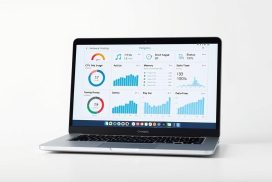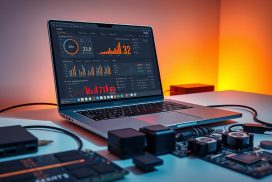Understanding Laptop Motherboard Architecture for Better Repairs
The laptop motherboard is a crucial component that houses various elements responsible for the device’s functionality. By gaining a deeper understanding of its architecture, technicians can improve their diagnostic and repair skills. The motherboard consists of components such as the CPU, RAM, storage connectors, power connector, GPU, I/O ports, expansion slots, BIOS/UEFI chip, audio codec, network adapters, VRM, and system controller hub. Each component plays a vital role in the laptop’s operations, and understanding their functions is essential for efficient repairs and troubleshooting.
When it comes to laptop repairs, having a comprehensive understanding of the motherboard architecture is crucial. It allows technicians to pinpoint potential issues accurately and provide effective solutions. Whether it’s diagnosing performance-related problems, resolving memory management issues, or troubleshooting storage and power-related concerns, a sound knowledge of the motherboard’s components and their functions is invaluable.
Not only does understanding laptop motherboard architecture lead to better repairs, but it also contributes to enhanced laptop performance. With knowledge of how components such as the CPU, memory (RAM), storage connectors, and power connector work together, technicians can optimize performance, improve multitasking capabilities, and provide a seamless user experience.
As technology continues to advance, motherboard designs evolve with new features and improved efficiency. Staying up to date with the latest developments in motherboard architecture is essential for technicians to deliver superior technical proficiency in laptop repairs.
So, whether you’re a technician looking to enhance your skills or a laptop user seeking reliable repairs, delving into the intricacies of laptop motherboard architecture is a worthwhile pursuit. The better you understand the architecture, the better equipped you’ll be to troubleshoot issues and optimize laptop performance. Start exploring the fascinating world of motherboard architecture today and unlock new possibilities for laptop repairs.
Central Processing Unit (CPU)
The CPU, also known as the central processing unit, is like the brain of a laptop. It carries out instructions from the operating system and applications, allowing the laptop to perform various tasks. Situated prominently on the laptop motherboard, the CPU is safeguarded by a heat sink and fan combination to prevent overheating.
Understanding the functions and capabilities of the CPU is essential for diagnosing and resolving performance-related issues. By optimizing the CPU’s performance, technicians can enhance the overall efficiency and speed of the laptop.
In order to comprehend the CPU’s role in laptop functionality, let’s explore its key functions:
- Execution of Instructions: The CPU executes instructions from the operating system and applications, ensuring smooth task completion and seamless performance.
- Data Processing: It manipulates and carries out calculations on data, allowing the laptop to perform complex tasks efficiently.
- Cache Memory Management: The CPU manages cache memory, which stores frequently accessed data. This speeds up the execution of instructions and enhances performance.
- Control Unit: The control unit supervises and coordinates the activities of various components within the CPU, ensuring proper functioning and synchronization.
- Address Generation and Management: The CPU generates and manages memory addresses, allowing data to be stored and retrieved appropriately.
Having a thorough understanding of these CPU functions is crucial for diagnosing performance issues and troubleshooting laptop problems effectively. By identifying the root cause of CPU-related problems, technicians can implement targeted solutions and optimize the laptop’s performance for a better user experience.
Famous CPU Brands
CPU technology has advanced significantly over the years, with different brands offering a wide range of options. Some popular CPU brands widely used in laptops include:
| Brand | Notable CPUs |
|---|---|
| Intel | Core i9, Core i7, Core i5 |
| AMD | Ryzen 9, Ryzen 7, Ryzen 5 |
| Apple | Apple M1 |
These brands offer CPUs with varying performance levels and capabilities, catering to different user requirements and preferences.
Memory (RAM)
RAM, short for Random Access Memory, is a vital component of a laptop’s performance. It allows for efficient multitasking and seamless operation of demanding applications. Understanding the capacity, types, and speed of RAM is crucial for technicians in diagnosing and resolving issues related to memory management, slow performance, and system crashes.
On the laptop motherboard, RAM slots house memory sticks that store data temporarily while the laptop is in use. When you open multiple applications or perform multitasking activities, the RAM provides quick access to the data required by the CPU, avoiding the need to retrieve information from slower, long-term storage devices like hard drives.
Did you know? Upgrading your laptop’s RAM can significantly improve its multitasking capabilities and overall responsiveness. It allows for smoother transitions between applications and faster data processing, enhancing your productivity.
When troubleshooting laptop performance issues, technicians should consider the following factors:
- RAM capacity: Insufficient RAM capacity can lead to slowdowns, especially when running memory-intensive programs. Technicians should ensure that the amount of installed RAM meets the system requirements of the laptop’s intended use.
- RAM types: Different types of RAM, such as DDR3 and DDR4, have varying speeds and compatibility. Technicians should be familiar with the specific RAM type supported by the motherboard to identify compatibility issues or to recommend suitable upgrades.
- RAM speed: RAM speed, measured in megahertz (MHz), determines how quickly data can be transferred to and from the RAM. Faster RAM speeds facilitate smoother multitasking and faster data access. Technicians can optimize laptop performance by ensuring that the installed RAM is operating at its maximum supported speed.
Important: To determine the RAM capacity, type, and speed supported by a laptop, technicians can consult the laptop’s user manual, the manufacturer’s website, or use diagnostic software.
By having a thorough understanding of RAM and its role in laptop performance, technicians can effectively diagnose and resolve issues, ensuring that the laptop operates at its full potential.
To summarize, RAM plays a crucial role in multitasking and overall laptop performance. Technicians should consider factors such as RAM capacity, types, and speed when troubleshooting and optimizing laptop performance.
Storage Connectors
Storage connectors on the motherboard play a crucial role in enabling data storage and retrieval on laptops. These connectors allow the attachment of storage devices such as Solid State Drives (SSDs) or Hard Disk Drives (HDDs), providing users with the ability to store and access their data efficiently.
As a technician, it is important to be familiar with different types of storage connectors and their compatibility. This knowledge will help you troubleshoot issues related to data storage, drive recognition, and data transfer speeds, ensuring optimal performance for laptop users.
When diagnosing storage-related problems, understanding the function of storage connectors is essential. Whether it’s a loose connection or compatibility issues, being equipped with the necessary knowledge can make all the difference in resolving data storage issues effectively.
To help you gain a better understanding, below are some commonly used storage connectors:
- SATA (Serial ATA): This type of storage connector is widely used and supports both SSDs and HDDs, providing high-speed data transfer rates.
- M.2: M.2 connectors are commonly found in modern laptops and are used for connecting SSDs. These connectors are available in different sizes and support faster data transfer.
- PCIe (Peripheral Component Interconnect Express): PCIe connectors are mainly used for high-performance SSDs, offering faster data transfer rates compared to SATA connectors.
By understanding the different types of storage connectors and their capabilities, you can efficiently diagnose and resolve issues related to data storage on laptops. This knowledge will help you ensure that users’ data is secure and accessible, providing a seamless computing experience.
Power Connector
The power connector on the motherboard plays a vital role in the functioning of a laptop. It receives power from the laptop’s battery or AC adapter and distributes it to various components, ensuring smooth operations. Understanding the power delivery system is essential for diagnosing power-related issues and ensuring the laptop functions optimally.
One common problem that technicians often encounter is a laptop not powering on. This issue can be caused by a faulty power connector, which may need to be replaced. Similarly, if the laptop battery is not charging properly, it could indicate a problem with the power connector’s connection to the battery. Technicians should inspect the power connector and its surrounding components to identify any loose connections or damaged parts.
Moreover, sudden shutdowns during laptop usage can also be attributed to power connector issues. If the connector is not delivering power seamlessly to the components, the laptop may shut down abruptly. Technicians should check for any signs of overheating or damaged connectors that could affect the power delivery.
When working with the power connector, technicians must prioritize safety. It is crucial to ensure that the laptop is powered off and unplugged before attempting any repairs or inspections. Mishandling the power connector can lead to electrical hazards, damaging the laptop’s components or even causing personal injury.
To summarize, understanding the power connector’s functioning and troubleshooting potential issues is crucial for laptop repair technicians. By ensuring proper power delivery, technicians can resolve common problems such as laptops not powering on, battery not charging, and sudden shutdowns. Additionally, adhering to safety measures when working with the power connector is essential for a successful repair process.
Conclusion
The laptop motherboard is a vital component that serves as the foundation for a laptop’s functionality. With a deep understanding of its architecture and the functions of each component, technicians can effectively diagnose and repair issues, ensuring optimal performance for users.
By comprehending the intricate ecosystem of the motherboard, technicians can identify and resolve common problems such as faulty connections, overheating, or performance bottlenecks. This knowledge allows them to provide efficient repairs and enhance the overall user experience.
As technology advances, laptop motherboards continue to evolve, incorporating new features and improving efficiency. It’s essential for technicians to keep up with these advancements to provide superior technical expertise in laptop repairs. By staying updated and continuously expanding their knowledge of motherboard architecture, technicians can optimize laptop performance, prolong its lifespan, and deliver exceptional repair services.
FAQ
What is a laptop motherboard?
A laptop motherboard is a crucial component that houses various elements responsible for the device’s functionality.
What components are found on a laptop motherboard?
The components found on a laptop motherboard include the CPU, RAM, storage connectors, power connector, GPU, I/O ports, expansion slots, BIOS/UEFI chip, audio codec, network adapters, VRM, and system controller hub.
What is the role of the CPU on a laptop motherboard?
The CPU is considered the brain of the laptop as it executes instructions from the operating system and applications, and it is centrally located on the motherboard.
What is the function of RAM on a laptop motherboard?
RAM slots on the motherboard house memory sticks that store data temporarily while the laptop is in use. RAM is essential for multitasking and running demanding applications smoothly.
What are storage connectors on a laptop motherboard used for?
Storage connectors on the motherboard allow the attachment of storage devices such as SSDs or HDDs and enable the storage and retrieval of data on the laptop.
What is the purpose of the power connector on a laptop motherboard?
The power connector on the motherboard receives power from the laptop’s battery or AC adapter and distributes it to various components. It is crucial for powering on the laptop and charging the battery.
Why is understanding laptop motherboard architecture important for repairs?
Understanding laptop motherboard architecture helps technicians efficiently diagnose and repair issues, optimize laptop performance, and enhance the user experience. It also helps technicians stay updated with the latest advancements in motherboard technology.












